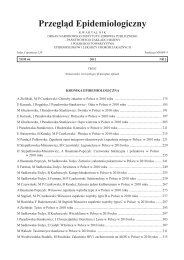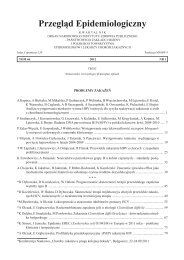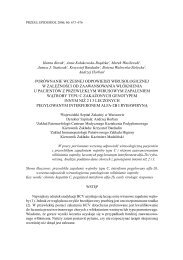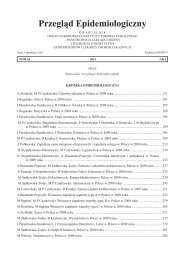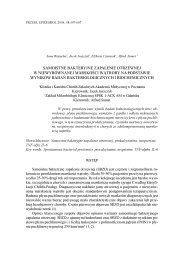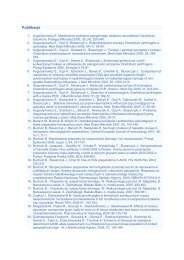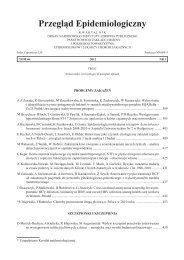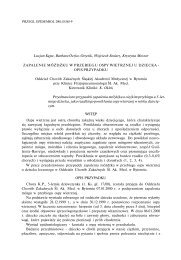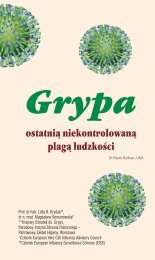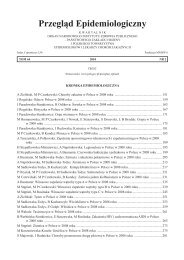Przegląd Epidemiologiczny - Państwowy Zakład Higieny
Przegląd Epidemiologiczny - Państwowy Zakład Higieny
Przegląd Epidemiologiczny - Państwowy Zakład Higieny
Create successful ePaper yourself
Turn your PDF publications into a flip-book with our unique Google optimized e-Paper software.
Nr 4<br />
Substancje antybakteryjne a rozprzestrzenianie się oporności bakterii 517<br />
przyczynić się do oszacowania potencjalnego ryzyka<br />
zakażenia pacjentów i personelu, występującymi w<br />
środowisku szpitalnym mutantami, opornymi na dezynfektanty.<br />
PIŚMIENNICTWO<br />
1. Russell AD, Suller MTE, Maillard JY. Do antiseptics<br />
and disinfectant select for antibiotic resistance. J Med<br />
Microbiol 1999; 48: 613-615.<br />
2. Kümmerer K. Significance of antibiotics in the environment.<br />
J Antimicrob Chemother 2003; 52: 5-7.<br />
3. Kümmerer K. Resistance in the environment. J Antimicrob<br />
Chemother 2004; 54: 311-320.<br />
4. Kümmerer K, Al-Ahmad A, Mersch-Sundermann V.<br />
Biodegradabiolity of some antibiotics, elimination of<br />
the genotoxicity and affection of wastewater bacteria in<br />
a simple test. Chemosphere 2000, 40:701-10.<br />
5. Russel AD. Biocide and antibiotic resistance the relevance<br />
of laboratory findings to clinical and environmental<br />
situations. Lancet Infect Dis 2003; 3: 794-803.<br />
6. Gromadecki J, Wróbel R. Składniki aktywne występujące<br />
w preparatach dezynfekcyjnych i antyseptycznych.<br />
Zakażenia 2010; 10: 29-36.<br />
7. Lambert PA. Bacterial resistance to antibiotics. Modified<br />
target sites. Adv Drug Deliv Rev 2005; 57: 1471-1485.<br />
8. Webber MA, Woodward MJ, Piddock JV. Disinfectant<br />
resistance in bacteria. W: Antimicrobial Resistance in<br />
bacteria of animal origin. ASM Press 2006; 8: 115-125.<br />
9. Russell AD. Bacterial adaptation and resistance to antiseptics,<br />
disinfectants and preservatives is not a new<br />
phenomenon. J Hosp Infect 2004; 57, 97-104.<br />
10. Braoudaki M, Hilton AC. Low level of cross-resistance<br />
between triclosan and antibiotics in E. coli K-12 and E.<br />
coli 055 compared to E. coli O157. FEMS Microbiol Lett<br />
2004; 235:305-309.<br />
11. Różalska B, Walencka E, Sadowska B. Wykrywanie biofilmów<br />
stanowiących problemy medyczne i perspektywy<br />
ich eradykacji. Zakażenia 2010; 10: 13-21.<br />
12. Levy SB. Active efflux, a common mechanisms for<br />
biocide and antibiotic resistance. J Appl Microbiol 2002;<br />
92: 65-71.<br />
13. Suller M, Russel AD. Triclosan and antibiotic resistance<br />
in Staphylococcus aureus. J Antimicrob Chemother 2000;<br />
46: 11-18.<br />
14. McMurry LM, McDermott PF, Levy SB. Genetic evidence<br />
that InhA of Mycobacterium smegmatis is target for<br />
triclosan. Antimicrob Agents Chemother 1999; 43:711-3.<br />
15. Poole K. Mechanisms of biocide and antibiotic resistance.<br />
J Appl Microbiol 2002; 92: 553-645.<br />
16. Tattawasart U, Maillard JY, Furr JR, Russell AD. Outer<br />
membrane changesin Pseudomonas stutzeri resistant to<br />
chlorhexidine diacetate and cetylpryridium chloride. J<br />
Antimicrobial Agents 2000; 16: 233-238.<br />
17. Paulsen IT. Multidrug efflux pumps and resistance: regulation<br />
and evolution. Curr. Opinion in Microbiology<br />
2003; 6: 446-451.<br />
18. Morita Y, Murata T, Mima T I in. Induction of mexCD-<br />
-oprJ operon for multidrug efflux pump by disinfectants<br />
in wild-type Pseudomonas aeruginosa PAO1. J Antimicrob<br />
Chemother 2003; 51: 991-994.<br />
19. Stewart PS, Costerton JW. Antibiotic resistance of bacteria<br />
in biofilms. Lancet 2001; 358: 135-38.<br />
20. Sundheim G, Langsrud S, Heir E, Holck AL. Bacterial<br />
resistance to disinfectants containing quaternary ammonium<br />
compounds. Int Biodeter Biodegrad 1998; 41:<br />
235-239.<br />
21. Randall LP, Cooles SW, Piddock LJV, Woodward MJ.<br />
Effect of triclosan or a phenolic farm disinfectant on the<br />
selection of antibiotic-resistant Salmonella enterica. J<br />
Antimicrobial Chemother 2004; 54: 621-627.<br />
22. Block C, Furman M. Association between intensity of<br />
chlorhexidine and microorganisms of reduced susceptibility<br />
in hospital environment. J Hosp Infect 2002; 51:<br />
201-206.<br />
23. Aniello AE, Cimiotti J, Della-Latta P, Larson EL. A<br />
comparison of the bacteria found on the hands of “homemarkers”<br />
and neonatal intensive care unit nurses. J. Hosp<br />
Infect 2003; 54:310-315.<br />
Otrzymano: 28.06.2010 r.<br />
Zaakceptowano do druku: 31.08.2010 r.<br />
Adres do korespondencji:<br />
Dr Agnieszka Chojecka<br />
Zakład Zwalczania Skażeń Biologicznych<br />
Narodowego Instytutu Zdrowia Publicznego - PZH<br />
ul. Chocimska 24, 00-791 Warszawa<br />
e-mail: achojecka@pzh.gov.pl<br />
tel.: (022) 54 21 330



